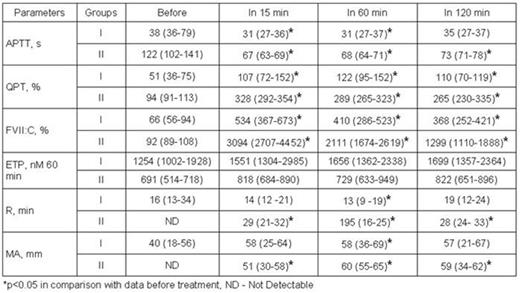Abstract
Background: Administration of rFVIIa is used as a method of choice in the treatment of hemophilia pts with inhibitors. Besides, rFVIIa may be useful in thrombocytopenic pts with inefficiency or impossibility of platelet transfusions due to alloimmunization or religious beliefs.
Aim: The aim of the present study was to compare the effects of rFVIIa on hemostasis in thrombocytopenic pts and hemophilia pts with inhibitors.
Patients and Methods: rFVIIa was used in 20 pts with thrombocytopenia (I group) and in 20 hemophilia pts with inhibitors (II group). Indications for use of rFVIIa in thrombocytopenic pts were: gastrointestinal and intra-abdominal bleeding, intracranial hemorrhage, insertion of the central venous catheter, lumbar puncture, bleeding from the femoral artery puncture site, epistaxix and pulmonary hemorrhage. In thrombocytopenic pts blood platelet count varied from 1*109/l to 72*109/l (median 15 *109/l). The media dose of rFVIIa in thrombocytopenic pts was 79 μg/kg (ranges from 50 to 144 μg/kg). All hemophilia pts received a single dose of rFVIIa (90 μg/kg). All pts received rFVIIa (Generium, Russia). APTT, Quick prothrombin test (QPT), FVII:C level, endogen thrombin potential (ETP) and Thromboelastography (TEG) parameters (R, MA) were evaluated before and after rFVIIa administration.
The median and interquartile range (IQR) were calculated as descriptive statistics. Mann-Whitney U test and Mood's median test were used to evaluate group differences. Statistical analyses were performed with SAS 9.1 (using the Npar1way procedure).
Results: rFVIIa was effective in all hemophilia pts. Administration of rFVIIa in 15 min shortened but did not correct APTT, increased QPT and ETP, FVII:C (Table 1). Prior to treatment the hemophilia pts have no clotting determined by TEG, but after rFVIIa administration TEG demonstrated close to normal pattern. In thrombocytopenic pts after rFVIIa administration bleeding stopped in 51% pts, decreased in 44% and did not change in 4% pts. In thrombocytopenic pts maximal hemostatic effect was achieved within 1 hour after rFVIIa administration (Table 1). 1 case of ischemic stroke was obtained. The maximum effect of rFVIIa in thrombocytopenic pts coincided with decrease of plasma activity of FVII perhaps due to its consumption.
Conclusion: In the most hemophilia pts with inhibitors the response was achieved within 15 min of administration of rFVIIa. In thrombocytopenic pts haemostatic effect of rFVIIa was delayed and reached within 1 hr, good response was achieved in 51% pts.
Parameters of hemostasis before and after rFVIIa administration expressed as a median (IQR)
Parameters of hemostasis before and after rFVIIa administration expressed as a median (IQR)
No relevant conflicts of interest to declare.
Author notes
Asterisk with author names denotes non-ASH members.


